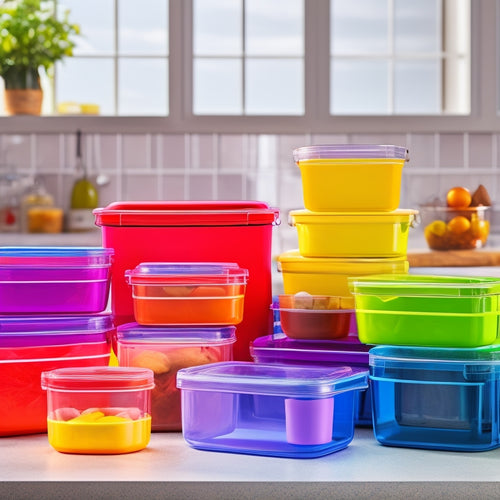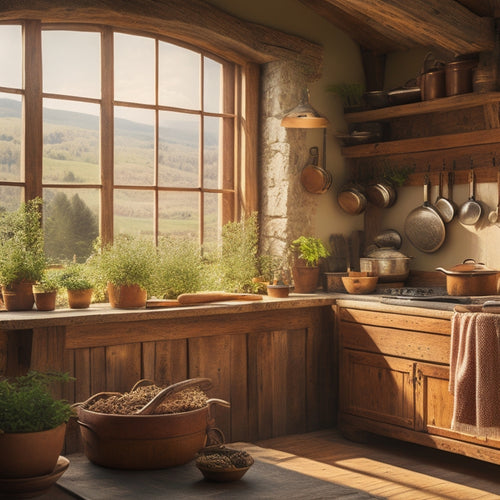
Organize Kitchen Utensils for Small Families Easily
Share
To easily organize kitchen utensils for your small family, start by evaluating your cooking habits and utensil needs, then purge unnecessary items to declutter your space. Categorize remaining utensils by type and frequency of use, and consider investing in multi-functional tools to maximize storage capacity. Utilize vertical storage spaces, such as hooks and shelves, to optimize storage. Designate zones for utensils in the kitchen, grouping similar items together for efficient workflow. By following these steps, you'll be well on your way to a clutter-free kitchen. And with a few more tweaks, your kitchen can become a culinary haven tailored to your family's unique needs.
Key Takeaways
• Assess your kitchen utensil needs based on cooking habits and meal preparation to prioritize essential items.
• Purge unnecessary items, donating or discarding duplicates, broken, or outdated utensils to create space for essentials.
• Categorize utensils by type and frequency of use, creating zones in the kitchen for easy access while cooking.
• Choose multi-functional tools, like kitchen shears, to maximize storage capacity and simplify cooking tasks.
• Utilize vertical storage spaces, such as hooks and stackable shelves, to optimize storage capacity and keep frequently used items at eye level.
Assess Your Kitchen Utensil Needs
What kitchen utensils do you really need, and which ones are just taking up space? Evaluating your kitchen utensil needs is essential in organizing your kitchen efficiently. Take some time to reflect on your cooking habits and the type of meals you prepare for your small family. Consider the frequency of use, the number of people you're serving, and the available storage space in your kitchen.
Prioritize items that are necessary for your daily meal prep, such as a good set of knives, a cutting board, and a few pots and pans. Identify the utensils that you use regularly, like a can opener, wooden spoons, and a spatula.
Be honest with yourself - if you haven't used it in the past year, you probably don't need it. Make a list of the must-haves and the nice-to-haves. This exercise will help you determine what you really need to keep and what you can let go of, freeing up valuable space in your kitchen.
Purge Unnecessary Kitchen Items
With your prioritized list in hand, start clearing out the clutter by gathering all the unnecessary kitchen items that didn't make the cut. Be ruthless – if you haven't used it in the past year, it's likely you won't miss it. Consider adopting a minimalist lifestyle and apply the KonMari method to your decluttering process.
| Item | Action |
|---|---|
| Duplicates | Donate or repurpose |
| Broken items | Discard |
| Unused gadgets | Consider selling or donating |
| Outdated items | Replace with newer, more efficient models |
As you purge your kitchen, remember that everything you remove is an opportunity to serve others. Consider hosting a donation drive or passing items along to friends and family who might appreciate them. By letting go of the unnecessary, you'll create space for the things that truly bring you joy and make cooking easier. Take a deep breath and get rid of anything that's holding you back from a more organized, clutter-free kitchen.
Categorize Kitchen Utensils Wisely
Now that you've purged your kitchen of unnecessary items, it's time to categorize the remaining utensils into groups that make sense for your cooking habits and available storage space.
Start by grouping similar items together, such as baking utensils, cooking utensils, and serving utensils. This will help you see what you have and where it can be stored.
Next, categorize your utensils by frequency of use. This will help you prioritize which items should be easily accessible and which can be stored out of the way.
When categorizing, consider the space you have available for storage. Think about the 'zones' in your kitchen, such as a baking zone or a cooking zone, and store utensils accordingly. This will save you time and energy when cooking.
Remember, utensil organization is key to efficient storage solutions. By categorizing your utensils wisely, you'll be able to find what you need quickly and easily, making cooking and serving a breeze.
With a little planning and creativity, you can create a kitchen that's functional, efficient, and easy to navigate.
Choose Multi-Functional Tools
By selecting multi-functional tools, you'll maximize your kitchen's storage capacity and reduce clutter. This is especially important for small families, where every inch of space counts.
Look for space saving solutions that can perform multiple tasks, such as a utensil that can chop, slice, and dice. These versatile tools will simplify your cooking tasks and reduce the number of gadgets you need to store.
For efficient cooking, consider investing in a multi-functional cookware set that can be used for sautéing, boiling, and steaming. This won't only save you space but also reduce the time spent on meal prep.
Another great option is a kitchen shears that can be used for a variety of tasks, from cutting herbs to opening packaging.
Utilize Vertical Storage Spaces
You can further optimize your kitchen's storage capacity by making the most of its vertical spaces, where oft-overlooked areas like walls, cabinets, and ceilings can be repurposed to hold utensils, cookware, and other essentials. By doing so, you'll be able to maximize space and keep your kitchen countertops clutter-free.
One effective way to utilize vertical storage is by installing hooks. You can hang items like pots, pans, utensils, and even aprons from hooks attached to the walls or ceiling. This won't only free up cabinet space but also make it easier to access frequently used items.
Consider using stackable shelves or baskets to store items like plates, bowls, and cups. You can also use adhesive magnets to store small metal items like spices, oils, or knives on the sides of cabinets or appliances.
Remember to keep frequently used items at eye level, and less frequently used items towards the top or bottom of your vertical storage spaces.
Designate Zones for Utensils
To maintain a clutter-free kitchen, assign specific zones for utensils, grouping similar items together, such as baking tools near the oven and cooking utensils near the stove. This helps you quickly find what you need while cooking.
When designating zones, consider the workflow in your kitchen. Place frequently used items in easy-to-reach areas, and less used items towards the back or in harder-to-reach spots. You can customize drawers by installing dividers or inserts to separate utensils, making it easier to find what you need. This also helps maximize space, as utensils are stored in a compact and organized manner.
For example, designate a zone near the sink for dishwashing utensils, and another near the countertops for food preparation tools. By doing so, you'll create a more efficient workflow and reduce clutter. Remember to store utensils in a way that makes sense for your cooking habits, and adjust as needed.
Store Heavy Items Below
What's the heaviest item in your kitchen, and where do you store it? You probably have a few heavy pots, pans, or appliances that take up valuable space.
To maximize your kitchen's storage capacity, store these heavy items below countertops or sinks. This will help keep your countertops clutter-free and make it easier to access the items you need.
Install hanging racks or overhead hooks to hang pots, pans, and utensils. This won't only free up cabinet space but also keep your countertops clear.
For items that are too heavy to hang, consider using drawer dividers or under sink storage to keep them organized and out of the way.
Label and Sign Utensil Stations
Create designated stations for your most frequently used utensils and label them clearly with signs or stickers to guarantee easy identification and quick access. This way, you'll save time searching for the right tool, and your kitchen will feel more organized.
To take it to the next level, consider color coding your labels to categorize utensils by type, such as baking, cooking, or serving. This visual system will help you and your family members quickly find what you need.
To add an extra layer of organization, use magnetic strips to store utensils like spices, oils, or frequently used condiments on the side of a cabinet or fridge. This will free up counter space and keep your stations clutter-free.
You can also use adhesive hooks to hang utensils like pots, pans, or cooking utensils, keeping them within easy reach. By labeling and signing your utensil stations, you'll create a kitchen that's functional, efficient, and enjoyable to cook in.
Frequently Asked Questions
Can I Use Adhesive Hooks to Hang Utensils on a Tile Backsplash?
'Get a grip on utensil organization! You can hang utensils on a tile backsplash using adhesive hooks, but be cautious of their weight capacity and establish a strong bond to avoid damage or falls, considering magnetic strips as an alternative.'
How Do I Prevent Water From Collecting in Utensil Holders?
You'll prevent water from collecting in utensil holders by ensuring good utensil drying and water drainage; add drainage holes or slats to your holders, and position them to allow air circulation and water runoff.
Are Silicone Utensil Organizers Easy to Clean and Maintain?
As you envision a kitchen haven, imagine silicone utensil organizers shining like beacons of ease, offering a hassle-free cleaning experience - they're dishwasher safe, ensuring a sparkling clean, and boast long-lasting durability, making your life simpler.
Can I Repurpose Old Kitchen Items as Utensil Organizers?
You can breathe new life into old kitchen items by repurposing them as utensil organizers, showcasing your creative solutions and DIY projects. Upcycling ideas and household hacks can help you create functional and eco-friendly storage solutions.
Are Over-The-Sink Shelves Suitable for Storing Kitchen Utensils?
Imagine having a clutter-free kitchen where utensils are within easy reach. You'll love over-the-sink shelves for storing kitchen utensils, maximizing kitchen storage in small spaces while keeping your countertop organized and clutter-free.
Related Posts
-

Stackable Kitchen Containers for Modular Systems
Stackable kitchen containers for modular systems change your cooking space by maximizing vertical storage and enhanci...
-

Rustic Hanging Racks for Country-Style Kitchens
Rustic hanging racks are a game changer for your country-style kitchen, blending functionality with charm. They maxim...
-

Revolving Cabinet Organizer Lazy Susan
A revolving cabinet organizer like a Lazy Susan is a transformative solution for your kitchen. It maximizes space and...


